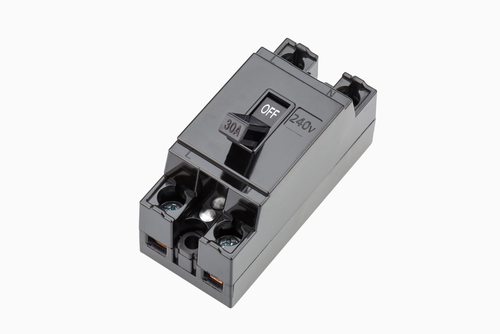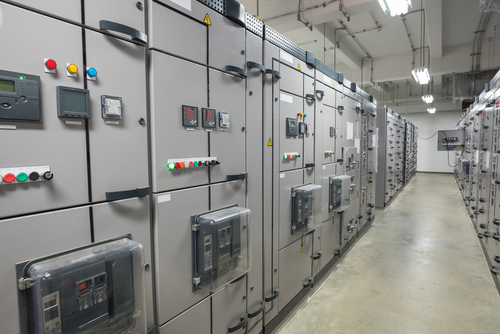An insulated case circuit breaker has all the characteristics of a molded case circuit breaker, with the addition of a two-step stored energy mechanism. Unlike the iron-framed breakers, they are constructed of molded plastic.
Insulated, also called molded or plastic breakers, generally are used in low amp applications up to 1,000 Amps. They operate either thermally or thermo-magnetically.
Air Circuit breakers are used for circuits from 800 Amps to 10,000 Amps. You can close air circuit breakers remotely. Most air breakers are controlled electronically, though some have microprocessors. You can usually fully adjust the trip thresholds and the delays. Originally, manufacturers developed the air circuit breaker, as they are very robust and could handle larger currents.
How Does an Insulated Circuit Breaker Work?

A standard insulated circuit breaker uses fixed or interchangeable thermal magnetic trip units. They contain a temperature sensitive device and a current sensitive electromagnetic device to mechanically trip the mechanism. The trip current can be adjusted.
Types of Insulated Circuit Breakers
Molded case circuit breakers come in a variety of sizes and types. If one breaks, you simply replace it, rather than repair it.
How Does an Air Circuit Breaker Work?
All circuit breakers prohibit re-establishment of arcing after current zero. An air circuit breaker creates an arc voltage greater than the supplied voltage. It does this in one of three ways:
- It can be cooling the arc plasma, which increases the arc voltage. This means the voltage gradient required to maintain the arc increases.
- Lengthening the arc path, which causes increased resistance and hence more voltage, is required to maintain the same arc current.
- It splits up the arc into a series of different arcs, which will increase the arc voltage.
Types of Air Circuit Breakers
Electrically operated air circuit breakers use an external power supply to open and close the switch. The power can derive from a single phase, 230V AC supply or a low voltage, 24V-110V DC power supply in case of a power outage.
There are three basic types of air circuit breakers.
The plain break type has two contacts, shaped like horns. The arc extends from the tip of one horn-shaped contact to the other tip.
The magnetic blowout air breaker extends the arc by a magnetic field produced by the blowout coils. These types have a voltage capacity of 11 KV.
The third type of air circuit breaker is called an air chute. This type has copper contacts that stay in the closed position. The breakers are silver plated and have very low resistance. The copper arcing contacts resist heat well.
Differences between Insulated Case and Air Circuit Breakers
There are several differences between insulated case and air circuit breakers. The amperage range for insulated case breakers normally runs up to 1600A. Air breakers start at around 630B and run up to 10,000A.
Air breakers have various parts that can be replaced or repaired, whereas insulated circuit breakers are constructed as one unit. If an insulated breaker fails, you replace the whole breaker unit.
Air breakers take up much more space than an insulated circuit breaker does. Molded breakers are very compact and even come in miniaturized versions. For example, the General Electric line of molded case breakers includes the SKHA36AT0800, with dimensions of 8.25” x 5.5” x 15.5”. The miniature version of this breaker with the same operating characteristics, such as the SGHA36AT0600, measures 5.5” x 3.81” x 10.09”.
In contrast, an air circuit breaker can be 3-4 times, sometimes more, larger.
The tripping mechanism of an air circuit breaker is much faster.
However, insulated breakers cost a fraction of the price of an air circuit breaker. Repairing an air circuit breaker is possible, but expensive. If an insulated circuit breaker fails, instead of buying parts, you simply remove and replace it with a new one.
Where Are Insulated Circuit Breakers Used?
Insulated circuit breakers are the most common type of breaker and have a variety of uses, from office buildings to homes.
Where Are Air Circuit Breakers Used?
Since air breakers trip much quicker, this makes them more popular for use in buildings or plants with higher risks of explosions or fires. For example, power station auxiliaries and industrial plants employ air circuit breakers.
Which One Should You Use?

The insulated case circuit breakers provide a much more cost-effective solution in most cases. Many different companies make quality molded case breakers, providing potential users with a range of features and sizes, depending on need.
Air circuit breakers have a specialty niche for hazardous locations. If fire and/or explosions have a higher likelihood of occurring due to the activities at a particular location, many consider the air breakers as a safer option over insulated breakers.
